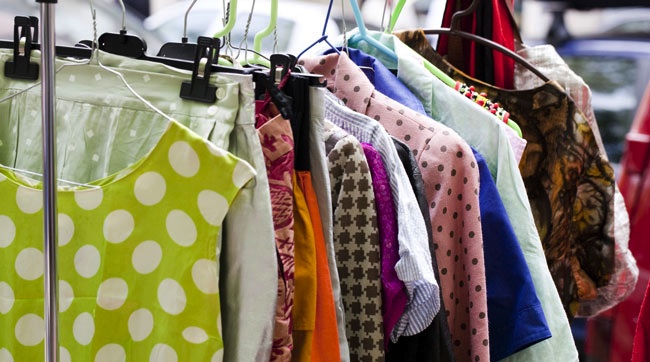Much of the advice out there for reducing your fashion footprint involves buying more sustainably made (and often expensive) clothes. But there are a number of ways – many of which we explore in our new Fashion issue – you can lower your impact that save money, both in the short- and long-term.
Much of the advice out there for reducing your fashion footprint involves buying more sustainably made (and often expensive) clothes. But there are a number of ways – many of which we explore in our new Fashion issue – you can lower your impact that save money, both in the short- and long-term.
One way is to hold a clothing swap, which is exactly what it sounds like: a group of people get together and trade clothes with one another. Swapping is an extra-familial version of hand-me-downs, and something friends – particularly those who can’t afford to buy new clothes all the time – have been doing intuitively for years. But more formally organized swaps of all sizes – including city-wide events – have been gaining recent popularity. My tips here are for smaller-scale events.
1. Where: Location, location, location
While city-wide events tend to be held in larger venues, small swaps among friends are usually held in someone’s living room. If you’ve got a tiny living space, you may want to tap another friend with roomier digs to play co-host. You’ll need space to lay out all of the clothes, plus at least one room for people to change in. Having a full-length mirror (or two) on hand is also incredibly useful.
2. Who: Plan for style, size and selection
While you want a wide enough variety of items for the swap to be interesting, you don’t want people with such vastly different styles that no one will like each other’s stuff. You also want to make sure no one’s the odd one out in terms of clothing size. Putting some thought into who you invite can help ward off both of these problems. Keeping in mind how much space you have to work with, inviting more people can also mean greater selection.
3. What: Set some boundaries
You might want to set some basic parameters as to what types of items guests should bring: Are shoes included? What about bras or lingerie? Accessories? Outerwear? People might not think to bring some of those things unless they’re suggested. The space you have available will also dictate how many piles of things you can fit.
It’s up to you whether you want to require that all attendees bring items to swap, and if you want to stick to a one-for-one or other ratio. People are often more eager to get rid of their excess items than to find more, so I haven’t found this to be necessary – and it makes swaps less accessible for those who might need it the most.
Specify in advance whether guests will be expected to take un-swapped items back home with them, or if you (or someone else with a vehicle) can take all of the leftovers to a shelter or second-hand store. If you’re planning on donating to a shelter, be sure to check with them in advance about what items they can accept and how much they can take at one time.
You might also want to include a reminder that items should be clean and in good condition (or easily repairable). If any attendees (especially a host) have pet allergies or are sensitive to fragrances, that’s definitely worth noting. Most laundry detergents leave strong scents behind and even clean clothes that have been in a cat-lover’s closet might be covered in hair.
4. How: Not quite a free-for-all
Sort clothes as guests arrive. shirts on one couch, pants on another, dresses on this chair, socks on the coffee table – you get the idea. This allows guests to target the items they’re looking for and keep track of what they’ve looked at already. You might choose to sort by size instead (or as well), if that’s a defining factor for your group.
Portable clothing racks are one way to add extra room and make it a bit easier to browse (provided you’ve got enough hangers). If you’re really short on space, one big pile can work, too. In that situation, try having a couple of people go through the pile and hold up individual items for everyone to see. (You can do this for the sorted piles, too, of course.)
Designate an area for people to stash the clothes they want. Or set aside bags or boxes so “claimed” items don’t get recirculated back into the piles.
Have a show-and-tell session. If everyone is browsing simultaneously, people are bound to grab items before others get a chance to see them. Once everyone’s done looking through the options and has selected the items they want, sit in a circle and share what you’ve each found. If you’ve got a big pile, be prepared to lose an item or two in the name of fairness.
If two or more people like a particular garment, talk it out. Does one person really love it, while the other just kinda liked it? Does one have a lot of other stuff they’re already taking home? Are there other pieces you both like, and can you divvy them up evenly? Who needs it more? Which person has more items at home that it will go with? There are a lot of factors you can draw on to arrive at a fair decision, but if you’re still stuck, and everyone’s friendly: have both (or all) contenders try it on and put it to a vote!
The best part of a swap can be seeing the clothes you’ve lost interest in brought to life again on someone else. Everyone wears things differently and it’s incredible how one item can be completely transformed on someone else’s body, or by someone else’s style.
Bonus tip: Wear leggings or bike shorts and a tight-fitting tank top so you can try everything on without having to strip down or find another room to change in.
Laura is a past A\J managing editor. She has an MA in Communication Studies from Wilfrid Laurier University, is an organizing aficionado, lackadaisical gardener, and former musical theatre producer. @inhabitings













